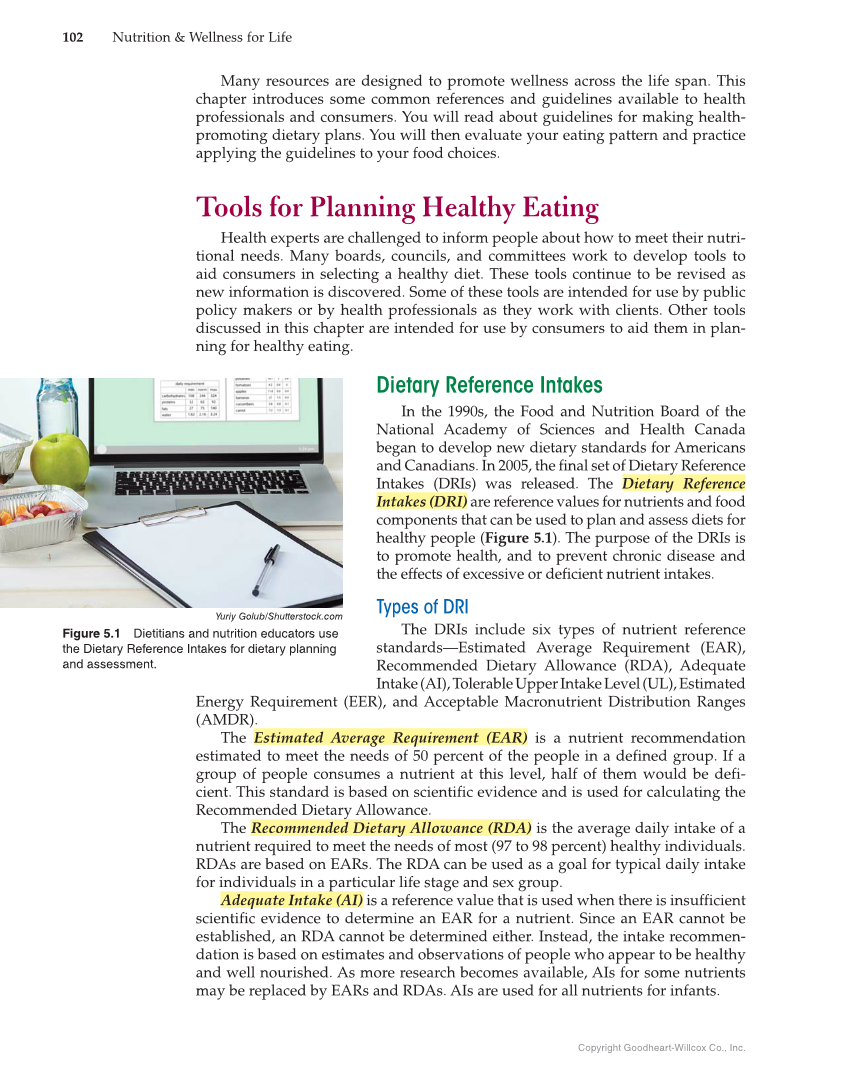102 Nutrition & Wellness for Life Copyright Goodheart-Willcox Co., Inc. Many resources are designed to promote wellness across the life span. This chapter introduces some common references and guidelines available to health professionals and consumers. You will read about guidelines for making health- promoting dietary plans. You will then evaluate your eating pattern and practice applying the guidelines to your food choices. Tools for Planning Healthy Eating Health experts are challenged to inform people about how to meet their nutri- tional needs. Many boards, councils, and committees work to develop tools to aid consumers in selecting a healthy diet. These tools continue to be revised as new information is discovered. Some of these tools are intended for use by public policy makers or by health professionals as they work with clients. Other tools discussed in this chapter are intended for use by consumers to aid them in plan- ning for healthy eating. Dietary Reference Intakes In the 1990s, the Food and Nutrition Board of the National Academy of Sciences and Health Canada began to develop new dietary standards for Americans and Canadians. In 2005, the final set of Dietary Reference Intakes (DRIs) was released. The Dietary Reference Intakes (DRI) are reference values for nutrients and food components that can be used to plan and assess diets for healthy people (Figure 5.1). The purpose of the DRIs is to promote health, and to prevent chronic disease and the effects of excessive or deficient nutrient intakes. Types of DRI The DRIs include six types of nutrient reference standards—Estimated Average Requirement (EAR), Recommended Dietary Allowance (RDA), Adequate Intake (AI), Tolerable Upper Intake Level (UL), Estimated Energy Requirement (EER), and Acceptable Macronutrient Distribution Ranges (AMDR). The Estimated Average Requirement (EAR) is a nutrient recommendation estimated to meet the needs of 50 percent of the people in a defined group. If a group of people consumes a nutrient at this level, half of them would be defi- cient. This standard is based on scientific evidence and is used for calculating the Recommended Dietary Allowance. The Recommended Dietary Allowance (RDA) is the average daily intake of a nutrient required to meet the needs of most (97 to 98 percent) healthy individuals. RDAs are based on EARs. The RDA can be used as a goal for typical daily intake for individuals in a particular life stage and sex group. Adequate Intake (AI) is a reference value that is used when there is insufficient scientific evidence to determine an EAR for a nutrient. Since an EAR cannot be established, an RDA cannot be determined either. Instead, the intake recommen- dation is based on estimates and observations of people who appear to be healthy and well nourished. As more research becomes available, AIs for some nutrients may be replaced by EARs and RDAs. AIs are used for all nutrients for infants. Yuriy Golub/Shutterstock.com Figure 5.1 Dietitians and nutrition educators use the Dietary Reference Intakes for dietary planning and assessment.
